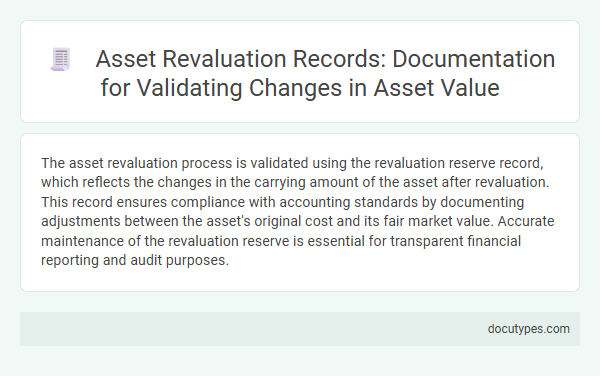The asset revaluation process is validated using the revaluation reserve record, which reflects the changes in the carrying amount of the asset after revaluation. This record ensures compliance with accounting standards by documenting adjustments between the asset's original cost and its fair market value. Accurate maintenance of the revaluation reserve is essential for transparent financial reporting and audit purposes.
Introduction to Asset Revaluation Records
Asset revaluation records are essential documents used to validate changes in the value of your financial assets. These records include detailed information such as the original asset value, revaluation date, and the adjusted amount based on current market conditions. Maintaining accurate asset revaluation records ensures compliance with accounting standards and provides transparency in financial reporting.
Importance of Accurate Asset Valuation Documentation
Asset revaluation is validated through detailed asset revaluation records, which include updated book values, revaluation dates, and supporting appraisals. These records are crucial for maintaining accurate financial statements and ensuring compliance with accounting standards such as IAS 16.
Accurate documentation of asset valuations helps prevent discrepancies during audits and supports transparent reporting to stakeholders. Proper validation records enable companies to track value changes over time and make informed investment or divestment decisions.
Regulatory Requirements for Asset Revaluation Records
Asset revaluation records are validated through detailed revaluation reports and accounting entries that comply with regulatory standards such as IFRS and GAAP. These records document the adjusted value of assets and must include justification, valuation methods, and authorized approvals.
Regulatory requirements mandate maintaining comprehensive records, including external appraisals, board resolutions, and audit trails to ensure transparency and accuracy. Proper validation supports financial statement integrity and facilitates regulatory audits and compliance reviews.
Key Components of Effective Revaluation Documentation
Accurate asset revaluation documentation is essential for validating changes in asset values during financial reporting. A comprehensive record ensures transparency, compliance, and reliability in financial statements.
- Revaluation Report - A formal document prepared by certified appraisers detailing the updated asset value and the basis for revaluation.
- Supporting Evidence - Includes market comparisons, valuation models, and expert opinions that substantiate the revaluation figures.
- Approval Records - Documentation of authorization from relevant management or boards confirming the validation and acceptance of the revaluation.
Methods for Recording Changes in Asset Value
| Record Type | Description | Purpose | Common Methods |
|---|---|---|---|
| Revaluation Surplus Account | Special equity account used to capture increments in asset value after revaluation | Validates and tracks increases in asset value without affecting profit or loss directly | Credit asset increase to this account; Update asset ledger to new fair value |
| Asset Ledger Account | Primary accounting record reflecting the book value of each fixed asset | Displays revalued amount of asset for accuracy in financial statements | Adjust asset cost or accumulated depreciation to record new value |
| Revaluation Reserve | Equity reserve created to hold gains from asset revaluation | Acts as a buffer to absorb changes in asset values without impacting operational income | Debit previous asset value, credit reserve; reflect changes under OCI (Other Comprehensive Income) |
| Valuation Report | Independent appraisal document supporting new asset values | Provides evidence required to justify adjustments made to asset records | Use qualified professional valuations; attach report to accounting records for audit trails |
| Journal Entries | Accounting entries made to reflect the revaluation adjustments | Records changes in asset value systematically in ledger accounts | Debit or credit asset and related equity accounts, follow accounting standards such as IFRS or GAAP |
When managing your asset revaluations, accurate records like these ensure compliance and transparency in your financial reporting.
Audit Trails and Verification Processes
Asset revaluations are validated through detailed audit trail records that document each adjustment made to the asset's carrying amount. These records typically include the original valuation, revaluation date, new asset value, and the responsible personnel's authorization.
Audit trails ensure transparency and accountability by providing a chronological record of all changes, allowing auditors to trace the validity of revaluations. Verification processes involve cross-referencing revaluation reports with market data and independent appraisals to confirm accuracy. Maintaining comprehensive records supports compliance with accounting standards like IAS 16 and enhances financial statement reliability.
Common Challenges in Asset Revaluation Documentation
Asset revaluations require precise documentation to ensure accuracy and regulatory compliance. The primary record used for validation is the revaluation report, which must detail changes and justify adjustments.
- Inconsistent Valuation Methods - Different approaches in assessing asset values can lead to discrepancies and auditing challenges.
- Incomplete Supporting Documentation - Missing appraisals, market data, or approval records undermine the validation process.
- Poor Record Maintenance - Failure to update and securely store revaluation documents increases risk of errors and non-compliance.
Best Practices for Maintaining Asset Value Records
Asset revaluations require accurate and verifiable records to ensure financial statements reflect the true value of assets. Maintaining detailed asset value records supports compliance with accounting standards and improves decision-making.
- Revaluation Register - This record logs all changes in asset values with dates, amounts, and supporting documentation to validate revaluations.
- Supporting Valuation Reports - Independent appraisals or market analyses provide evidence for the adjusted asset values recorded in financial statements.
- Audit Trail Documentation - Detailed entries in the accounting system track who performed the revaluation, when, and the rationale behind the adjustments.
Consistent updating and secure storage of these records are essential best practices for maintaining asset value integrity.
Technology Solutions for Asset Revaluation Tracking
What record is used to validate asset revaluations in finance? The primary record for validating asset revaluations is the asset ledger, which provides a detailed history of asset values and adjustments. Technology solutions like blockchain and automated ledger systems enhance accuracy and transparency in tracking these revaluation records.
What Record Is Used to Validate Asset Revaluations? Infographic

